

Tidal Exchange
Newsletter of the Elkhorn Slough Foundation Spring 2010

From the Ridgelines to the Tide Lines
Landmanagement requires forward thinking and takes great patience. It is an incremental process with results measured in years, not weeks or months. The purpose of conserving land is not just to hold it, but to enhance the environment, expand habitat, and improve water quality. Over time, ESF has made impressive progress - hundreds of acres restored, gullies recontoured and planted with native grasses, and invasive species controlled. While it is easy to measure success in terms of acreage of uplands acquired and restored, it can be very challenging to detect whether the objective of improved water quality has been achieved. Land trusts nationwide struggle with this challenge. Many factors unrelated to restoration also affect water quality, in particular interannual variation in rainfall. Furthermore, decreases in pollution through one restoration project may be offset by increased
pollution from other lands in the watershed. Due to these complications, very few studies verify the direct positive correlation between restoration work and watershed well-being.
In a groundbreaking research study that’s garnering national attention, Elkhorn Slough researchers have statistically demonstrated that the land acquisition and restoration projects of ESF and ESNERR have directly translated into improved water quality in the watershed. The results are published in this month’s edition of the peer-reviewed scientific journal Estuaries and Coasts.
The ESNERR researchers Alison Gee, Kerstin Wasson and John Haskins employed the statistical test BeforeAfter-Control-Impact (BACI), to tease apart differences due to restoration from those due to interannual variation in weather or other factors. To run this type of test, it is vital to have several years of data from four different data sets: prior to restoration, following
restoration, sites where restoration has occurred, and sites where no restoration happened. Elkhorn Slough is one of the few areas nationwide where there is sufficient data to run the BACI test.
Data collection in the slough dates back to 1988, when scientists from Moss Landing Marine Laboratories and ESF had the foresight to initiate consistent water quality sampling at sites in two dozen wetlands of the Elkhorn Slough watershed. The program has been expanded and carried on for the past decades by the Elkhorn Slough Reserve and the Monterey County Water Resources Agency. Volunteers have collected the water samples in the field. On a shoestring budget but with the strength of partnerships between organizations and with volunteer help, these longterm monitoring data have been collected, enabling implementation of the powerful BACI test for restoration effects. (continued on page 2)
photo by Paul Zaretsky
Elkhorn Slough Foundation
Board of Directors
Steve Webster
President
Steve Dennis
Vice President
Richard Hammond
Treasurer
Jim Van Houten
Secretary
Judith Connor
Terry Eckhardt
Bill Eggleston
Steve Green
Anne Olsen
Lydia Villarreal
Tom Williams
Mary Wright
Staff
Mark Silberstein
Executive Director
Kate Raymundo
Administrative Director
Kim Hayes Stewardship Director
Ken Collins
Land Steward
John Kenney
Farmland Manager
Kevin Contreras
Land Acquisition Specialist
Gabriele Estill
Grants Manager
Lorili Toth Director of Development & Communications
Diane Tworog Development & Communications
Caryn Hodges
Bookkeeper
Emily Bacon
Administrative Assistant
PO Box 267, Moss Landing California 95039
Tel: (831) 728-5939
Fax: (831) 728-7031 www.elkhornslough.org
Tidal Exchange
Editor:
Diane Tworog
(continued from front page)
The research study examined two major projects led by ESF, restoration of the lands draining into the Azevedo wetlands and Porter Marsh. At the Azevedo wetlands, buffers were created between the farmed lands and the wetlands with the steepest lands taken out of production. Along Carneros creek, acquisition of various key properties allowed steep eroding slopes to be restored, and land management practices to be improved in the areas that continue to be farmed. In both areas, water quality significantly improved after restoration when compared to an adjacent control site (Kirby Park) where no restoration had occurred.
In a groundbreaking research study Elkhorn Slough researchers have statistically demonstrated that the land acquisition and restoration projects of ESF and ESNERR have directly translated into improved water quality in the watershed.
iiiiThe study also investigated the water quality implications of managing tide gates. Tidal exchange is restricted to the Azevedo wetlands by culverts under the railroad berm, and to Porter marsh by tide gates under Elkhorn Road. Long-term monitoring data revealed that water quality dramatically improved during periods where culverts or tidegates allowed more tidal exchange than in periods where they strongly limited tidal exchange. Indeed, the improvements due to increased tidal exchange were more dramatic than those due to land management. Changes in land management can reduce inputs of sediments, nutrients and chemicals. At the same time, habitat quality for estuarine resident fish or birds can be greatly improved locally simply by allowing for increased tidal flushing.

Study co-author Kerstin Wasson concludes, “Long-term monitoring data made possible by strong partnerships and dedicated volunteers have taught us that extensive restoration near wetlands combined with wise management of water control structures can improve water quality to support the rich estuarine biodiversity of Elkhorn Slough.”
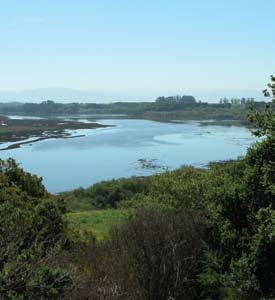
iiiiIn summary, this pioneering study has demonstrated that the land acquisition and restoration projects of ESF have directly translated into improved water quality. We can assert with certainty that ESF’s and ESNERR’s forward thinking and dedication to our long-term mission and goals have made a measurable, positive difference. And our science and land management techniques continue to break new ground and set examples for land trusts nationwide.
ESNERR volunteer Sue Shaw has collected water samples for this study for 20 years.
A Haven for Wildlife
Hikingon Foundation lands, you will commonly encounter deer, wild turkeys, and scat of larger bobcats, coyotes and even mountain lions. In order for these animals at the top of the food chain to thrive, there must be solid, dynamic plant and animal base and sufficient acreage of contiguous habitat. ESF restores diverse habitats so that all species have sufficient acreage to coexist.
ESF has been able to “knit together” parcels of land that encompassed fragments of once more extensive habitats. This work was very much like assembling a 3-D jigsaw puzzle.
Today, the Foundation owns and manages a large, connected corridor of lands in the northern highlands of the watershed. Restoration projects have healed many of the negative impacts from land use. Ecosystems are growing and flourishing. Smaller species, such as frogs, gophers, and birds, have re-populated the area. Recently, the larger mammals are reemerging and becoming more common. In the coming year, the land stewardship team
will remove several fence lines that once separated properties to create a spacious wildlife corridor while maintaining a safe distance from residential areas.
In the slough itself, otters, sea lions, seals and large birds are evidence that conservation efforts have been successful. The largest concentration of California Sea Otters, nearly 6 percent of the entire population, resides in Elkhorn Slough. As any kayaker knows, seals and sea lions are plentiful. Throughout the year, more than 300 species of birds, including herons, brown pelicans, godwits, and egrets call the slough home.
The word about Elkhorn Slough as a nature hot spot is spreading as quickly as our wildlife corridor. The slough was recently named by USA Today Weekend as one of the “top 10 places nationwide to see nature’s creatures” and the Los Angeles Times highlighted Elkhorn Slough as one of “10 fabulous pit stops between Los Angeles and San Francisco.” We invite you to come out and enjoy this special place.
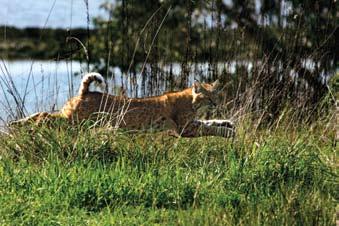
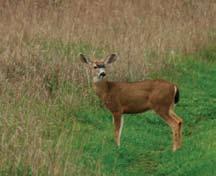
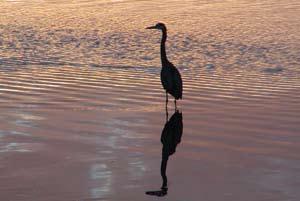

Founded in 1982, Elkhorn Slough Foundation is a community-supported 501(c) (3) nonprofit whose mission is to conserve and restore Elkhorn Slough and its watershed.
Members support these activities.
The Foundation has spearheaded innovative and cutting-edge research, conservation and educational programs in Elkhorn Slough. The Foundation now owns and/or manages nearly 4,000 acres — the largest conservation holdings in the Elkhorn watershed.
Since its inception, the Foundation has been directly involved in the restoration of over 1,000 acres of key habitats, including tidal wetlands, coastal prairie, oak woodlands, freshwater ponds, riparian corridors and maritime chaparral.
A board of directors, composed of conservationists, attorneys, educators, farmers, academics, business people, scientists and community volunteers, governs the Foundation.
Elkhorn Slough Foundation is a member of the national Land Trust Alliance and adheres to its recommended standards and practices. For more information, please visit www.landtrustalliance.org.
Photo by Malone Hodges
Kayakers Paradise
Kayaking enthusiasts trek to Elkhorn Slough for what many call one of the best kayaking experiences in the state. From first time paddlers to kayak aficionados, the slough is a popular draw for everyone. It’s easy to see why-- rafts of dozens of otters play and curiously approach your boat, seals poke their heads above the calm water, brown pelicans dive for dinner, and egrets pose gracefully on the mudflats. Conservation efforts throughout the watershed have ensured that the slough remains a premier kayaking destination. The trip itself, if timed correctly with the pull of the tides, can be a gentle ride up and down the entire 7 mile slough channel. Ron Eby, slough volunteer extraordinaire, often leads groups on tours. Ron took a few minutes to share how to make the most of your kayak trip.

Last summer Ron witnessed a fantastic show as a sea lion caught a leopard shark. The sea lion was so engrossed in eating that it ignored him and he was able to get lots of photos.
What’s so special about kayaking in the slough? Elkhorn Slough is unique. Not only is it the largest wetland between San Francisco and Morro Bay, but it is the only place in the world where you can see dozens of seals and sea otters and hundreds of sea lions within minutes of launching in Moss Landing Harbor. Elkhorn Slough is famous for its variety of birds and deservedly so. Grebes, brown and white pelicans, Brandt, pelagic and double crested cormorants, and many species of shore birds are always present.
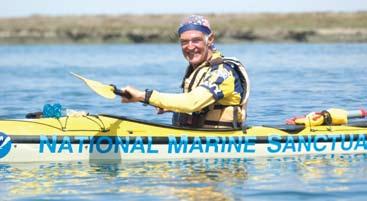
How long have you been kayaking in the slough? I’ve been kayaking the slough for nearly a decade now. I got hooked quickly and began volunteering with TeamOCEAN. TeamOCEAN is a NOAA sponsored organization that has volunteer kayakers on the water, both in Monterey and Elkhorn Slough, Friday, Saturdays and Sundays from Memorial Day to Labor Day.
Can you share an “insider tip?” My best tip for paddlers is to not paddle. It is so easy to get engrossed in your kayak and paddling that you overlook the things around you. You don’t have to get somewhere -- you are already there. Look around you and let yourself drift with the current. Look down in the water, look for bat rays and nudibranchs in the eel grass, look for birds on the shore and in the air, look behind and see the curious seal following your kayak, listen for the otter cracking open its clam.

Why is conservation important for kayaking? We wouldn’t have the kayaking mecca we have in Elkhorn Slough without conservation. After the harbor inlet was built in 1947, there were plans to build a marina and housing complex that would have made Elkhorn Slough much like the boating and housing area in Newport, California. Fortunately, conservation prevailed. The power plant, once fueled by oil and discharging directly into the slough, is now fueled by natural gas and discharges into the bay. Part of the exhaust from the power plant now runs under Dolan Road to one of only two CO2 sequestration plants in the world that can actually turn the power plant pollutants into cement. This cement plant occupies buildings left by the Kaiser Refractory. Think about it -buildings that used to be a source of pollution have been recycled into buildings that reduce pollution. Moss Landing, which used to be a whaling station, is now the center for conservation and education organizations like the Monterey Bay Aquarium Research Institute, Moss Landing Marine Labs, and Okeanis. The twenty dairies and many farms in the Elkhorn Slough watershed decades ago had little concept of the impact their runoff had on Elkhorn Slough’s health. Today, farms have implemented practices to reduce runoff. The Elkhorn Slough Foundation and the Nature Conservancy have acquired land and implemented conservation practices.We should be thankful for the conservation efforts to date, but the job is never done. There is always more we as individuals and organizations can do, to maintain and enhance our kayaking treasure. Don’t litter and don’t pollute. Volunteer with one of the many organizations that are protecting the slough like the Elkhorn Slough Reserve, or donate to the Elkhorn Slough Foundation. Conservation is not someone else’s job -- it’s each of ours.
Helping out in the Gulf
As we go to press, Ron Eby is volunteering with the International Bird Rescue Research Center, helping track and rescue oiled birds in the Gulf Coast. His message of hope- “This is an extraordinary effort with people coming together to help.” While news reports may be bleak, its heartening that there are citizens like Ron doing great work.

SuStaining the Legacy honoring the PaSt, Looking to the Future
Throughout its history the Elkhorn Slough Foundation has been fortunate to have the support and leadership of key community members. The Foundation’s Board of Directors – past and present – is an illustrious list of individuals from agriculture, science, environment, and business. This dedicated group of conservation leaders is the bedrock to ESF’s success.
On Sunday, May 16th we honored our past leaders including Diane Porter Cooley, John Warriner, Lou Calcagno, Dick Nutter, Anne Olsen, and Jim Van Houten for their excellences in building a lasting legacy and creating the vision of the Elkhorn Slough Foundation. Current board member Terry Eckhardt and his wife Cathleen hosted the event at their beautiful Soquel home. The 70 guests, representing ESF’s founders, board, volunteers, members, and staff enjoyed inspiring conversation of shared memories and future hopes.
Celebrity chef Wendy Brodie demonstrated a tasty and simple recipe for sustainable salmon, which was also part of the excellent meal catered by Wendy. The “Art of Food” cooking show hosted by Wendy can be seen on your local public television channel each weekend.
Diane Cooley, one of ESF’s founding board members, attributed some of ESF’s success throughout the years to the “light, but steady touch” of Executive Director Mark Silberstein and the Foundation’s ability to engage and encourage collaboration among the business, conservation, and agricultural communities. Diane summed it all up in one line that stated the importance of working together in the mud without “throwing mud.”






Cleaning up the Neighborhood
Picking up roadside trash isn’t high on anyone’s list of fun weekend activities. But on Saturday, April 17th, the week before Earth Day, more than 35 community members gathered at Kirby Park to clean up Elkhorn Road and surrounding neighborhoods near Carneros Creek and Blohm Road. Despite the dirty task at hand, the volunteers were energetic and enthusiastic to help. In just a few hours, the crew filled a 30 yard dumpster. Trash included everything from fast food wrappers and diapers to televisions. A majority of the volunteers live within the watershed and recognize the importance of cleaning up their neighborhoods. Thanks to Margie Kay, longtime Elkhorn Slough volunteer, for organizing the event once again.
Top to Bottom: ESF Board member Tom Williams helps Chef Wendy Brodie demonstrate a recipe; ESF Founder Diane Porter Cooley; Guests enjoy the festivities; Santa Cruz County Supervisor Neal Coonerty & Monterey County Supervisor Lou Calcagno; Hosts Cathleen & Terry Eckhardt
Watershed residents
Klaus Kloeppel & Suiyee Fenwick pose for a photo at Clean Up Day

Heading for Sound Conservation
Injust 13 years since ESF became a land trust, we have completed 37 transactions involving $32.4 million and 3,073 acres. Together, ESF and ESNERR manage 66 percent of all the protected lands in the watershed, a total of 5,300 acres. All decisions to manage land are strategically evaluated by ESF staff and board to ensure they meet longterm conservation goals.
A recent independent report by researchers at the University of California, Davis has used Elkhorn Slough as a case study for testing an innovative conservation planning tool. Patrick Huber, postdoctoral scholar with the Department of Environmental Design, utilized Marxan software to evaluate conservation priorities in the Elkhorn Slough watershed. Marxan is spatial software designed to pinpoint optimal conservation targets by evaluating biodiversity goals and proximity to existing conserved lands.
Cal Trans and other agencies propose to use the Marxan tool as a way to identify potential impacts of highway projects on natural environments and to find appropriate ways to mitigate those impacts. “Elkhorn Slough is such a ‘data-rich’ environment” says ESF Executive
Director Mark Silberstein, “that UC Davis was able to use it as a case study to test assumptions about the power of the computer model.” Dr. Huber and his team used the vegetation and habitat maps ESF developed for our conservation efforts.
Huber concluded that 95% of the lands that ESF and ESNERR have acquired and manage fall within the model’s “best solution for conservation.” This story draws similarities to the tale of John Henry and the railroad - a test of man versus machine. In this case, the data-gathering work of humans validates the work of the machine. In the long term, other agencies can use the Marxan software to increase their confidence in their human efforts of assessing environments in areas that have less background information and hard data than Elkhorn Slough. Is this any way to run a railroad? It is when the tracks are heading for sound conservation!

Endangered Santa Cruz Long-toed Salamander Discovered
NinaD’Amore, ESNERR Amphibian and Freshwater Ecologist, waded into chest deep water at Cattail Swale and dipped her net into the pond. She pulled it up and was thrilled to discover three Santa Cruz Long-toed Salamander larvae. Larvae of the salamander, which has been federally listed as endangered since 1967, had not been found on the Reserve since 2005.
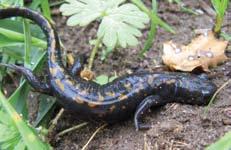
Further sampling quickly found an additional four salamander larvae, making it likely that there are many more larvae in the 2-acre pond. Nina stresses, “This is an exciting find - if they hadn’t bred in the pond this year, it might have meant that the population here on the Reserve would blink out.” As these animals live less than ten years, a population could probably only go a maximum of 5 years without breeding successfully.
Santa Cruz Long-toed Salamanders lay eggs singly or in small clusters. The eggs hatch into larvae, which is essentially the stage equivalent of a frog’s tadpoles. Aside from the recent discovery at Cattail Swale, D’Amore is aware of small Long-toed Salamander populations only at Oxbow Pond in Las Lomas which is protected by the Elkhorn Slough Foundation and the Agricultural & Land Based Training Association (ALBA), McClusky and Zmudowski Sloughs and parts of Moro Cojo Slough. Small populations also likely exist in pockets elsewhere in Monterey and Santa Cruz counties.
Hikers pause to appreciate the watershed’s biodiversity.

Slough View
Nesting Owls
This spring, the owl boxes in the old Elkhorn Dairy barn have been particularly crowded. A Great Horned Owl and her two offspring took up residence in front box, while a family of Barn Owls moved into the box at the back of the barn. Although Barn Owls are a common occurrence at the Reserve, the Great Horned Owls are a special treat. Adding to the uniqueness of the situation, Great Horned Owls are known to prey on the smaller Barn Owls. This year, however, everyone co-habitated the barn peacefully. The owls fledged their nests in late May.

Kevin Contreras, ESF Land Acquisition Specialist
Conservation of the earth’s natural systems and services is a monumental challenge that fundamentally shapes the legacy we bequeath to future generations. The strategies and methods of conservation work vary according to unique goals and regional conditions. Conservation strategies range from policy development and product invention, to beach cleanups and recycling. For land trust organizations - such as ESF - land acquisition and management is a key method used to meet conservation objectives.
Land acquisition is most useful when the primary goal is to protect specific acreage forever. Acquisition usually occurs in two forms: 1.) acquiring title to a property (through purchase or donation) or 2.) acquiring a conservation easement, or certain rights to a property. Title acquisition is more expensive, but is most effective when extensive restoration projects are necessary to improve the property. Easement acquisition may be most appropriate to maintain a particular land use, such as to protect existing marshlands or to preclude damaging development on a property.
Land acquisition is most successful when it occurs in strategic locations such as adjacent to existing reserves or to link otherwise isolated reserves. Some acquisitions follow terrain features such as a coastlines, ridge lines or waterways.
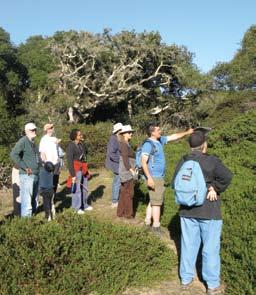
ESF Land Steward points out maritime chaparral at ESF’s Long Valley 428 acre property, acquired in 1999. Without ESF’s acquisition, Long Valley likely would have become a subdivision.
It is also essential to look at the bigger picture and develop an acquisition strategy in conjunction with a land management plan that outlines restoration projects. For example, on lands that had experienced erosion, stabilizing fragile soils and preventing the loss of sediment, chemicals and nutrients into downstream wetlands involves both the acquisition of the property as well as restoration efforts. By fallowing steep slopes, restoration allows the re-growth of native habitat, sequesters carbon and helps replenish groundwater.
While land acquisition is just one of many tools used for conservation, it is one of the most strategic. It has a long tradition in the U.S. starting in 1872 with the acquisition of Yellowstone National Park. In Elkhorn Slough, conservation acquisition started in 1968 in Monterey County and has continued ever since. Today more than 8,000 acres, much of the most important habitat, has been acquired and is being protected by a collaboration among eight agencies and organizations, with ESF as a key leader managing 45% of the protected lands. Together, we are ensuring the slough’s rich environments persist into the future.
The Great Horned Owl has secured rabbit for dinner.
Photo by Michael Carl.

Elkhorn Slough Foundation
P.O. Box 267
Moss Landing, CA 95039
Moss
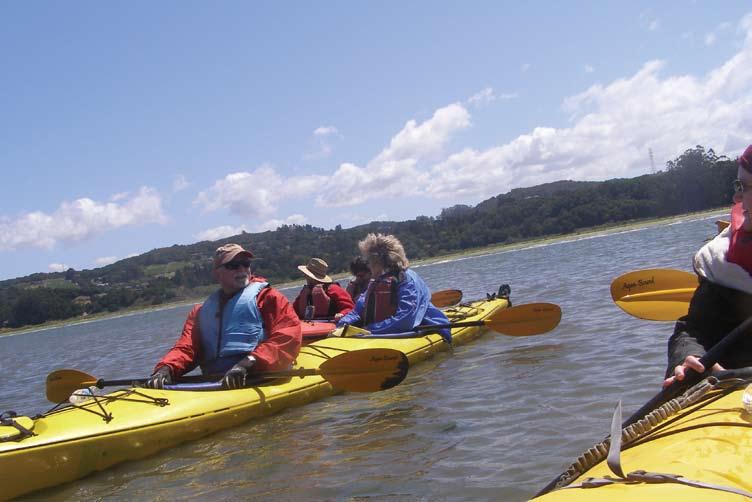
Join us!
If you’re not yet a member of Elkhorn Slough Foundation, we hope you will join today. Your membership directly supports the conservation and restoration of one of California’s last great estuaries and the abundance of life centered here.
Member Benefits
Members receive a 10% discount at the Elkhorn Slough Bookstore located in the Reserve Visitor Center, and invitations to ESF member events, including walks on our lands, our annual celebration and kayak tours of the north Slough. We will keep you informed of our work through Tidal Exchange & our on-line news alert, Slough Buzz.
Get Involved with Elkhorn Slough!
There are many exciTing ways To geT involved wiTh elkhorn slough!
Lend your green thumb at Nursery Drop-In the 2nd Wednesday of each month (Call Bree at 831-728-2822 x305).
Attend our next volunteer training and become an expert on all things Elkhorn Slough (Call Amanda at 831-728-2822 x303).
For our members, we offer exciting hikes, lectures and special events throughout the year (Visit www.elkhornslough.org for a complete schedule).
Events Calendar
Elkhorn Slough National Estuarine Research Reserve & Visitor Center 1700 Elkhorn Road, Watsonville, CA (831) 728-2822
Open Wednesday–Sunday, 9:00 a.m.–5:00 p.m.
Early Bird Tours First Saturday each month, 8:30 a.m. Join expert Rick Fournier for early birding. Meet at the Visitor Center; $2.50 day-use fee.
Docent-led Tours of the Reserve Saturdays & Sundays 10:00 a.m. & 1:00 p.m. Tours meet rain or shine at the Visitor Center; $2.50 day-use fee.
